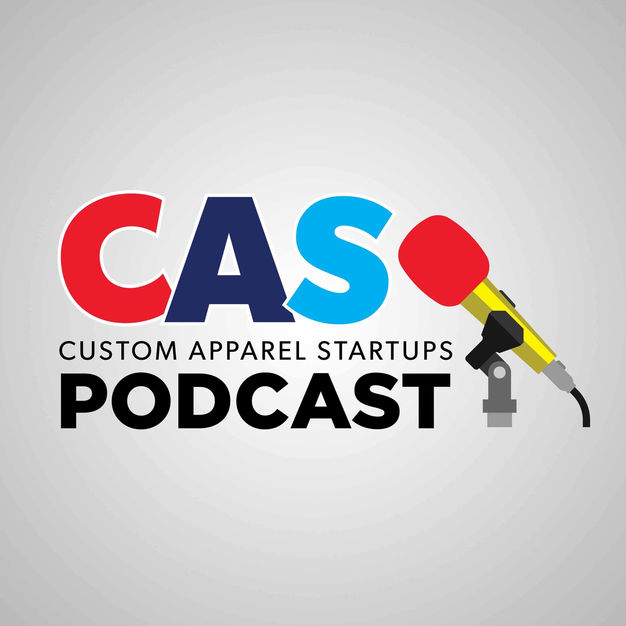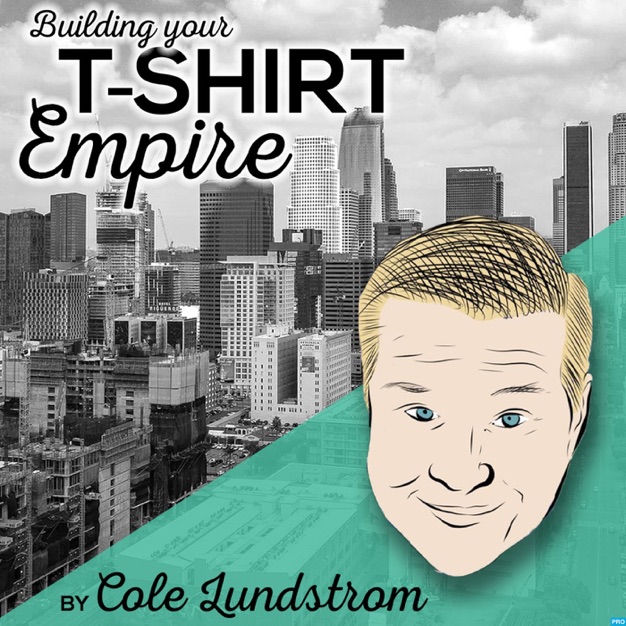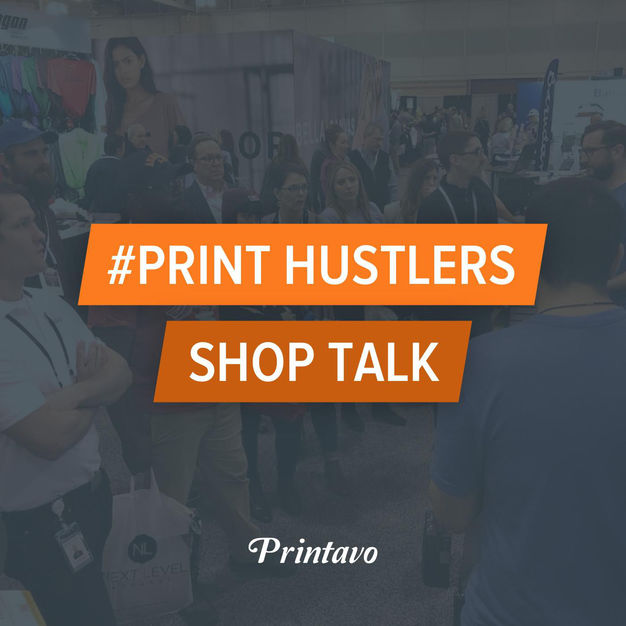
Custom Apparel Startups
Custom Apparel Startups
The Custom Apparel Startups podcast was started simply because we love both the apparel decorating business and the idea that almost anyone, with a small investment and a little dedication, cannot only start their own business but thrive!
- 40 minutes 52 secondsEpisode 200 - The Secret to Selling Tshirts Right Away
In this episode, we dive into the exciting world of entrepreneurial spirit with a focus on launching a custom t-shirt business. We'll explore a practical, step-by-step guide designed for beginners eager to make a mark in the t-shirt industry, even with little to no prior experience. Whether you've dabbled in t-shirt sales or are just curious about this creative venture, this episode is your gateway to starting a successful side hustle immediately.
We’ll dissect a downloadable document that outlines six actionable strategies that have proven successful for startups across the country. From leveraging your personal network to making smart use of social media and local community engagement, we cover all the bases to ensure you're well-equipped to start generating business right away.
Join us as we reveal the secrets to turning referrals into sales, using everyday interactions as promotional opportunities, and why something as simple as a well-timed text message or a social media post can be incredibly effective. If you're ready to start making money by selling custom t-shirts, this episode will provide you with the knowledge and inspiration to hit the ground running. Tune in to transform these insights into action and start achieving your dreams today!
20 June 2024, 2:13 pm - 1 hour 59 secondsEpisode 199 - Growing A Customization Business
In this insightful episode, we sit down with Trevor and Trent Walden, the pioneering duo behind the Walden Bros., an Alaskan t-shirt shop specializing in Direct to Film (DTF) printing and embroidery. As they navigate the intricacies of the customization industry, the Walden brothers share their journey of transforming an idea to a successful family business.
Key Discussion Points:
Taking ideas and going for it: The Walden Bros. recount their initial days, emphasizing the importance of good ideas, family and hard work.
Taking Risks: Trevor and Trent delve into early wins and losses that helped make the business it is today.
Building a Brand: The brothers explain their approach to creating a strong brand identity that resonates with their customers.
Customer Engagement: They highlight strategies for engaging customers and personalizing experiences to foster loyalty and repeat business.
Challenges and Triumphs: The conversation also covers hurdles they've faced, how they've overcome them, and the lessons learned along the way.
This episode not only provides a behind-the-scenes look at running a successful customization business but also serves as a guide for entrepreneurs eager to carve out their own niche in the competitive industry of bespoke products. Join us as Trevor and Trent Walden lay down the blueprint for aspiring customizers looking to expand their horizons.12 June 2024, 8:48 pm - 52 minutes 58 secondsEpisode 198 - How To Convert A Screen Printing Shop To DTF
In this episode, we delve into the exciting world of Direct to Film (DTF) printing and how you can transition your screen-printing shop to embrace this innovative technology. We'll start by explaining what DTF printing is and why it's gaining popularity. Next, we'll break down the investment costs involved, giving you a clear picture of what to expect financially.
We'll explore the wide variety of materials you can print on with DTF and detail the essential equipment you'll need to get started.
Wondering if you should keep your screen-printing machines?
We'll weigh the pros and cons to help you make an informed decision.
Additionally, we'll discuss other important factors to consider during the transition, provide insights into the current DTF market, and guide you on how to obtain a sample DTF print to see the quality for yourself.Whether you're a seasoned screen-printer or new to the industry, this episode is packed with valuable information to help you navigate the switch to DTF printing. Tune in and learn how to expand your printing capabilities and stay ahead in the competitive market.
5 June 2024, 9:06 pm - 59 minutes 25 secondsEpisode 197 - DTF vs Screenprinting
In this insightful episode of Custom Apparel Startups, we welcome Howard Potter back to discuss the nuances between Direct to Film (DTF) printing and traditional Screen Printing. With his deep-rooted knowledge from A&P Master Images, Howard breaks down the pros and cons of each technology, helping entrepreneurs make informed decisions tailored to their business needs.
The conversation begins with an overview of each printing method’s technical demands and operational scopes. Howard elaborates on the initial investment costs, ease of operation, and scalability potential of DTF and Screen Printing, giving listeners a comprehensive comparison.
Highlighting key factors like print quality, production speed, and cost-effectiveness, Howard shares his firsthand experiences with both methods. He discusses how DTF offers flexibility and precision with lower setup times, making it ideal for small to medium runs.
Conversely, Screen Printing is celebrated for its economic benefits in large batch productions and its lasting print quality.
Further, Howard addresses common misconceptions and challenges associated with each method, such as the steep learning curve of Screen Printing and the upfront costs associated with transitioning to or starting with DTF.
Listeners will come away with a clear understanding of which printing method might best suit their current operations and future growth plans, armed with Howard Potter’s practical advice and industry insights. Whether you're a startup in the apparel industry or looking to expand your existing setup, this episode serves as an essential guide to mastering these popular printing techniques.
23 May 2024, 6:02 pm - 40 minutes 32 secondsEpisode 196 - Overcoming Struggles of Growing a Business
In this compelling follow-up episode of Custom Apparel Startups, we're delighted to welcome back Howard Potter, of A&P Master Images, for another deep dive into the world of custom apparel. This time, Howard sheds light on the troubles encountered when starting a t-shirt business and shares invaluable advice for both new and established entrepreneurs in the industry.
Kicking off the episode, we tackle one of the most daunting questions for newcomers: "Which machine to buy?" We stress the importance of broad research and caution against getting tunnel-visioned on a single technology. The landscape of apparel printing is vast and choosing the right equipment is crucial for your business's specific needs and goals.
Growth is a central theme of our conversation. Howard underscores the necessity of forward-thinking, particularly in terms of spatial planning. Anticipating future expansion is vital; many businesses struggle because they run out of room or fail to utilize their current space efficiently. He offers practical tips on scanning your property and equipment regularly to identify items that can be repurposed or removed, thus making way for essential upgrades or additions.
Howard also introduces the concept of "temporary fixes" for immediate problems, but he warns against relying on these for too long. The discussion moves towards a critical analysis of production, time, and space utilization. He advises that operating at 95% capacity is a clear sign that expansion is overdue. Ideally, businesses should start thinking about improving their space or equipment when they hit the 70-75% threshold to avoid stagnation and ensure continuous growth.
Beyond the technical aspects of running a t-shirt business, Howard emphasizes the foundation of any successful venture: providing excellent service, treating people right, creating outstanding products, and committing to education and transparency. These principles, he argues, are non-negotiable for long-term success in the custom apparel industry.
This episode is a treasure trove of insights for anyone looking to navigate the challenges of starting or expanding a t-shirt business. Howard Potter's expertise and candid advice make it a must-listen for entrepreneurs eager to make their mark in the world of custom apparel.
Here is the list of tips for growing your business:
- Get the right equipment for YOUR business
- Consider the space you have to work and make sure you have room to grow
- If you are not using things or running out of room, be sure to scan your space and see how you can improve efficiency
- Consider your % output / % time / % space
- If you are at 95% production / space ... you need to expand
- Really you should be improving space / equipment at 70-75% rather than waiting
- Simple rules for growth
- Provide great service
- Treat people right
- Create a great product
- Educate your customer
- Be transparent
1 May 2024, 10:20 pm - 32 minutes 18 secondsEpisode 195 - What You Should Know Before Buying a DTF Printer
In the latest episode of Custom Apparel Startups, we are excited to feature Howard Potter, from A&P Master Images, who brings his wealth of knowledge to the table on the topic of Direct to Film (DTF) Printing. Our discussion, " What You Should Know Before Buying a DTF Printer," covers the A to Z of preparing to make an informed purchase of a DTF printer for your business.
Howard emphasizes the paramount importance of conducting thorough research to identify a trustworthy company. It's crucial to partner with a company that not only sells you a printer but also supports you throughout your printing journey. Equally important is considering the space your operation has available, as DTF printers come in various sizes and have specific space requirements for optimal operation.
He advises potential buyers to request samples from providers. This step ensures that the print quality meets your business's standards and expectations before making a significant investment. Additionally, Howard stresses the importance of investing in quality supplies, including inks and films, to guarantee the best output and durability of your printed products.
A central part of our conversation revolves around the challenges businesses might face, particularly concerning time management and staffing. DTF printing, while lucrative, demands careful planning and allocation of resources. Howard shares insights from his experience, noting that even the largest units are not overly complicated in terms of power requirements, which can be a common concern.
Highlighting the potential of DTF printing, Howard reveals an impressive fact: it is possible to generate more than $500,000 in revenue with a single DTF printer in a year. This statistic not only underscores the efficiency and profitability of DTF printing but also serves as a powerful motivation for businesses considering entering the space.
This episode is packed with invaluable advice for anyone looking to venture into DTF printing or expand their existing operations. Howard Potter's expert insights provide a roadmap for navigating the complexities of purchasing a DTF printer, making this episode an essential listen for those in the custom apparel industry.
Here are the top considerations before purchasing a DTF Printer:
- Find a company you can trust
- Consider the space you have to work with
- Get samples
- Look for a company that provides quality supplies with their machines
19 April 2024, 7:48 pm - 22 minutes 6 secondsCAS MiniCast - DTF Printing with Mike Angel
Mike Angel shares his expertise in apparel decorating, focusing on the cutting-edge technique called direct to film printing, or DTF printing for short. This method has completely revolutionized the world of apparel decorating, offering numerous advantages over traditional methods. It is not only faster and easier, but also more cost-effective and versatile.
With a DTF printer, you have the flexibility to take on both small and large-scale projects. You can effortlessly create and print the same design on a wide range of fabrics, allowing for endless possibilities in customization. Unlike other technologies, DTF transfers require lower temperatures and shorter press times, making it ideal for more delicate fabrics as well as durable fabrics.
DTF prints boast exceptional color and detail, surpassing many other apparel decorating methods for apparel decorating with photo-realistic images, and the prints are highly durable, withstanding stretching and washing with ease.
28 March 2024, 7:39 pm - 48 minutes 14 secondsEpisode 194 - Improve Online Sales with Shopify and ClickWear
In this episode of the CAS Podcast, we're thrilled to welcome Mike Angel from ColDesi, the brilliant mind behind ClickWear and the ColDesi OnDemand services. Mike takes us on a deep dive into the world of selling online, particularly through Shopify, and how ClickWear is transforming the custom apparel business by streamlining product creation and order management. We'll also explore the comprehensive solutions offered by ColDesi OnDemand, designed to support businesses in offering customized products without the hassle.
Shopify is a leading e-commerce platform that enables businesses of all sizes to set up their online stores and sell products. It's known for its ease of use, scalability, and comprehensive features that cover everything from inventory management to payment processing, making it an ideal solution for entrepreneurs looking to start or grow their online sales.
ClickWear is a Shopify app developed by ColDesi that revolutionizes the custom apparel industry. It allows store owners to easily create and sell custom-decorated products online by simplifying the design and order fulfillment process. ClickWear streamlines operations, enabling efficient management of product customization and orders directly from the Shopify interface.
https://coldesi.com/clickwear-a-shopify-app-for-the-custom-apparel-business/
ColDesi OnDemand offers a robust solution for businesses looking to offer custom apparel and products without the need for inventory. This service provides the technology and support for on-demand production, from printing to shipping, allowing businesses to focus on design and sales while ColDesi handles the fulfillment. It's a scalable solution that fits a range of business sizes and needs, from startups to established brands looking to expand their product offerings.
14 March 2024, 8:58 pm - 36 minutes 49 secondsEpisode 193 - It's Time to Raise Prices
Introduction
Small business owners in the customization industry are facing unprecedented challenges due to rising prices. This resource guide provides practical strategies to help your business thrive in a changing economic landscape.
Market Research and Competitive Analysis
- Research competitors and trends - Price shop around and see how you REALLY are in the market. Also ask about 'hidden' fees. Set up fees, art fees, delivery, etc.
- Do you have a fee to set up my logo?
- Do you deliver or do I pick up? Fees?
- I am trying to budget this all out, what other costs should I expect to make sure I allocate the right money?
- Understand customer perception - ask other business owners you know if they have had price increases. How did they deal with them? How large were they?
- Define your pricing strategy
- Do you want to be the price leader?
Keeping it Simple
- Avoid complex financial details.
- Don’t break down the cost of your ink, paper, deliveries etc. This leaves room for holes in your pricing strategy. Just keep it simple - 'my costs are up, my retail is up'
- Offer added value.
- Confident price change communication.
Transparency Matters
- Be open about price increases.
- Consequences of non-transparency.
- If you try to dance around the truth customers may see this as dishonesty
- Insights from Harvard Business Review.
- "Call the action a price increase, not a price adjustment, a price change, or another euphemism. While this may seem like a small thing, euphemistic messaging can cause serious harm, fraying the relationship with loyal customers." Many consumers are keenly aware of overall economic conditions, so when you tell your customers you’re raising prices, it just confirms their expectations, and most accept it.
- Use clear language.
- Postpone price increase for certain customers - let them know it’s coming, and why you are postponing for them.
Customer Satisfaction is #1
- Prioritize customer satisfaction first.
- Satisfied customers accept higher prices.
- Price-sensitive customers are likely to stay if satisfied. If they still won’t stay with higher prices, you have to decide if they are worth it.
- e.g. a low maintenance customer may be worth keeping at a lower margin. However a customer that is constant trouble, no referrals, frequent returns, frequent complaints… might not be worth it.
Additional Pricing Strategies
- Target new customers - Go after more unique niches or higher end customers
- Offer contract discounts - Can you get customers to commit to months or a year of service. e.g. make updated uniforms for their business every season, or update signs on storefront for each holiday.
- Create bundles - price of shirts is up, but if you do shirts AND hats you get a discount.
- Selective price increases - only price increase certain items. Maybe your low-price leading items stay the same, but your upsells increase.
Handling Customer Objections
- Address objections with confidence
- Brainstorm with your team or other business owners
- Practice the conversations
- Understand most customers will understand why this is happening
Conclusion
You empower your business when you control your prices. If you are racing to the bottom or let fear control your pricing, you will eventually start suffering consequences. Increasing pricing doesn't mean you are greedy, you are doing your best to stay in business and reach your financial goals.19 October 2023, 3:24 pm - Research competitors and trends - Price shop around and see how you REALLY are in the market. Also ask about 'hidden' fees. Set up fees, art fees, delivery, etc.
- 34 minutes 21 secondsEpisode 192 - How To Diversify Your Business
When it comes to growing your customization business we often talk about 'finding a niche.' What is a product / customer that you can focus on. This could be new moms, or local small businesses or tourists. However, you will find a point where growing that business becomes harder. This is why you will find a candle company that starts selling soaps, or why Bath and Body works sells 99 different ways to make your house smell good.
Diversifying your product lines is a great way to level up your business and make more money
- You can sell to current customers
- You can find a new customer base
- You can become more stable (as one product line slows down, another might grow)
Types of business diversification
- Product diversification: you primarily sell clothing but you want to expand into other items that will create value for your customer like home goods and accessories
- Market diversification: you have a local business and start selling online or you open a new location across town
- Industry diversification: take you knowledge to a different industry or target a new niche
- Service diversification: you may only offer finished products, but may want to start doing training on how to make those products
- Merge or Acquire: a business that has a different product, service, market or industry
Why you would want to diversify:
- Want more revenue.
- Core business is in decline or getting saturated.
- Less economic risk
- Increase competitiveness – offer a wider range of products to attract new customers and reach new markets that competitors can't or don't
Examples:
- Amazon used to be an online bookseller, then moved on to sell video games and other multi-media and before long, they sold computer electronics, software, homeware, toys, and more
- Apple was on the verge of bankruptcy in the 90's and launched the iPod and iTunes software and a few years later the iPhone
Steps to Diversify:
Do your research – have your customers suggested diversifying? Are they asking for more products or services? What can you do better than your competitors in your current or new markets? What type of diversification would suit your business?
Assess your risks – while diversifying can help generate sales and increase your market share, you have to find a crucial balance between finding the time and resources to focus on the new venture without neglecting your core business. Diversifying with similar products in a familiar market may carry less risk than developing a brand new product for an unknown market, but both would create a safety net which will allow you to recover if one of your products or services fails.
Audit your resources – what do you have and what do you need to invest in
Plan – in many ways it is like starting a new business. You will need to understand your new market, your customers, competitors, and the new dynamics just as you would for any new business
*What does your equipment do?**
You have an embroidery machine.
a) Do you sell hats?
b) Patches?
c) Uniforms?You have a DigitalHeat FX printer?
a) Ever used hard surface paper?
b) Printed on cardstock?*What adjacent equipment you can add?**
If you have a a sublimation printer, adding a hat press is an easy upgrade
If you do digitalheat fx, might be good to ad a sub printer or a cutter
If you do embroidery, going to a cutter and press.
4 October 2023, 2:13 pm - 38 minutes 56 secondsEpisode 191 - What Is The Best T-Shirt?
How do you choose the right t-shirt?
You are looking to start or grow your custom apparel business. There are a ton of challenges with choosing the right equipment, making sales, pricing your apparel and so much more. However, a topic not often discussed enough is the apparel you use.
Choosing the right blanks is a core part of your success. This is similar to a great chef. If you learn about great chefs, it's not just about the best pans and recipes, but also about the best ingredients. More so, it's about the best ingredients for their particular recipe.
The same thing applies to the custom apparel industry. You must pick the right apparel for your business. The idea of 'what is the best t-shirt' is a fallacy, just like the question of 'what's the best chocolate for a dessert'. It depends!
In this podcast we will discuss the idea of 'the best shirt' with an industry expert Mike Putnam. Mike has been in the apparel industry for over 30 years working in the apparel, sportswear and equipment industries.
Some of the questions we’ll answer in this episode include:
What is the best technology for your custom apparel business?
What type of T-shirts should you sell?
What problems should you expect?
How do you get past these problems?
Why is the idea of a ‘best’ shirt is a bit of a fallacy?
- Your process
- Your Technology
- Your customers’ needs (timeframe, color, quantity)
- The retail price you sell
What technology should you be printing with?
- Screen printing
- Direct to Film
- White Toner
- DTG
- Sublimation
Why do some shirts fail and others succeed in printing (even when they are the "same" material)?
How do you decide the best shirt for your business?
24 May 2023, 2:42 pm - More Episodes? Get the App
Your feedback is valuable to us. Should you encounter any bugs, glitches, lack of functionality or other problems, please email us on [email protected] or join Moon.FM Telegram Group where you can talk directly to the dev team who are happy to answer any queries.
 Building your T-Shirt Empire
Building your T-Shirt Empire
 Printavo PrintHustlers Podcast
Printavo PrintHustlers Podcast
 2 Regular Guys Talking Decoration
2 Regular Guys Talking Decoration